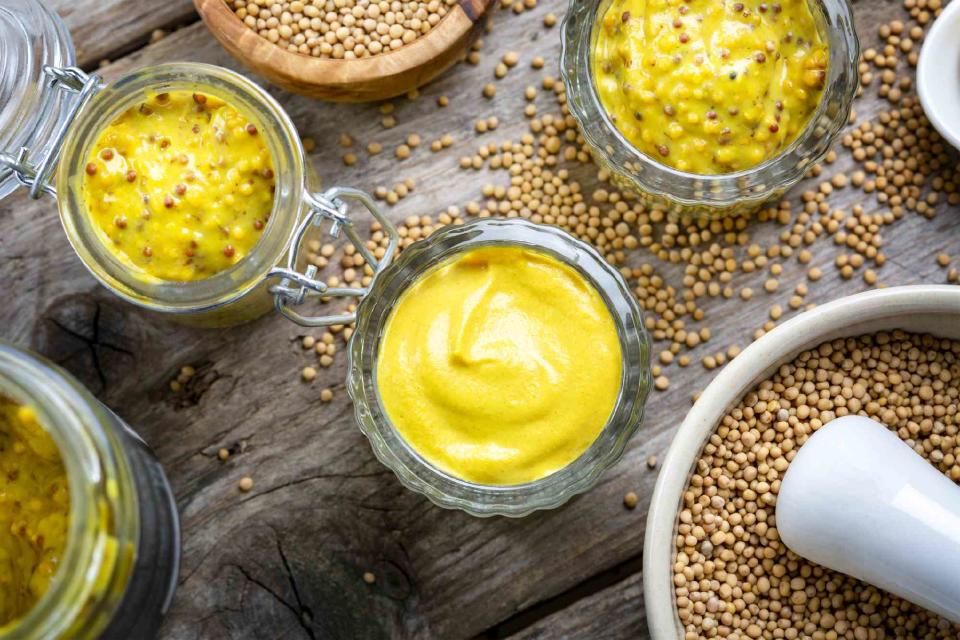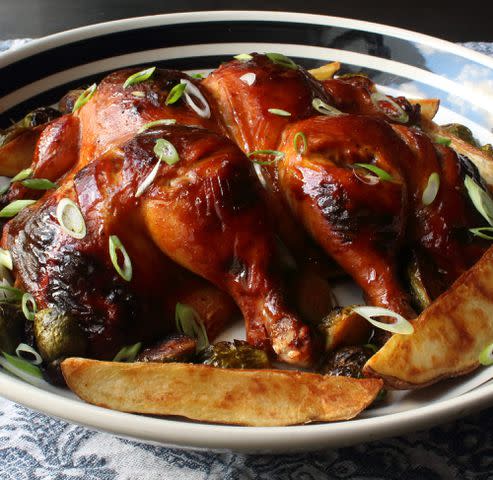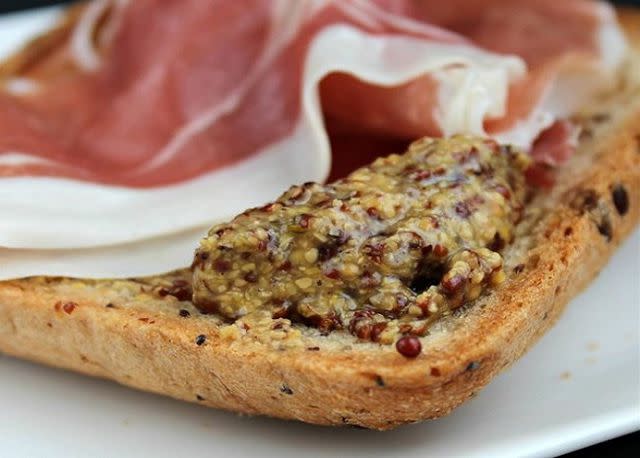Everything You've Ever Wanted to Know About Mustard
What you need to know about one of our all-time favorite condiments.

Cheeseburgers. Hot dogs. Sandwiches. Vinaigrettes. Bright yellow ballpark bites.
We see mustard everywhere. For many of us, just the idea of mustard conjures up happy memories. It has a versatility that is unmatched, and a history outdating darn near everything else in the culinary space. So, what exactly is this flavorful condiment and where did it come from?
Related: Dijon Mustard vs. Yellow Mustard: What's the Difference?
What Is Mustard? What Is It Made Of?
The mustard plant is a member of the Brassica family. It's grown from and produces seeds known unsurprisingly as mustard seeds. Black, brown, and white varieties are more pungent than the standard yellow we tend to see in squeezable bottle-form.
Mustard, known as moutarde in French, is most commonly known as a prepared condiment sold in jars or bottles. This spreadable product is a mixture of dried mustard seeds (whole or ground into a powder), water, vinegar, or other liquids. The mixture is blended until smooth and spreadable.

Get the recipe: Honey Mustard Roast Chicken
Most commercial mustard is made with white (yellow) or brown seeds — or a mixture of both. Black mustard seeds are rarely used in these blends but rather sold whole, typically in Indian and international markets, as they're common in Indian cooking.
The seeds are also sold in the spice isle or mixed in with the dry goods as dried mustard, ground mustard, or mustard flour.
Origins Of Mustard
What we know for sure is that mustard has been around since biblical times. It's one of the earliest spices recorded, appearing in Sanskrit manuscripts as early as 3000 BC. Beyond that, there are simply a lot of stories.
One such story centers on the Duke of Burgundy granting the city of Dijon a coat of arms fixed with the motto Moult Me Tarde, meaning "I ardently desire." This came out of gratitude for the city's military achievements in 1382. Apparently, while carving the motto into the city gates, the middle word was left out, leaving simply "moult tarde" or "burn much", which amused travelers and visiting tradesmen so much that they started using the word to refer to the local mustard seed.
Related: 4 Clever Ways to Use Mustard in and Out of the Kitchen
What Does Mustard Taste Like?
Mustard seeds on their own are quite potent, often described as fiery, with the brown variety bolder than the white. For prepared mustard, other added ingredients will make a difference in the taste. Whether the manufacturer adds wine or beer instead of vinegar, particular spices or herbs, and the degree to which the seeds are milled will give each jar its own personality.
Regardless, there is always an element of spiciness because of the nature of the seeds themselves, whether it be a mild, creeping heat or a ferociously hot one. Beyond that, mustard has an underlying sweetness, a hint of bitterness, and a bit of a floral aroma.
Types Of Mustard
Mustard tends to conjure images of a bright yellow bottle or fond memories of a ballpark. But it can also be the smear of grainy, seeded stuff on a charcuterie board or an exciting store find like a jar of dill mustard. All of these are types of prepared mustard, the form we use most often, but mustard also comes in seeds, powder, and oil.

Get the recipe: Beer Mustard
Mustard seeds are used in pickling spices and cooking after being toasted and gently cracked. Powdered mustard is also called ground mustard and is often added to sauces, vinaigrettes, or rubs, or used to make homemade prepared mustard. Mustard oil can be drizzled over finished food like olive oil would be for added flavor.
Prepared mustard comes in seven types: yellow, Dijon, brown (also called deli or ballpark), German, Chinese, English, and whole (or coarse) grain.
Yellow
This is a well-known classic. The pointy bright bottle from our youth. The mustard is made with ground white seeds, so the bold yellow color comes from turmeric instead. The taste reads acidic rather than hot and is popular on hot dogs or sandwiches, but not so much in cooking.
Dijon
Dijon is made with brown (and sometimes black) seeds and is brown in color, but it is not "brown mustard." The major differences are that it is only made in the French town of Dijon (there are strict, government-defined standards for the stuff and if it isn't made here, it must be labeled "Dijon-style") and that it's made with white wine, toning down its acidity and letting the natural pungency and heat of the mustard shine.
Related: Quick BBQ Sauces for When You Need It Now
Deli (American Brown or Ballpark)
This brown mustard is made from brown seeds, has a mild spice, and isn't as tart as yellow. It might have a coarser texture and speckled look if the hull is left on the seeds. Depending on the brand, deli mustards might use additional spices, like nutmeg or allspice to create a unique flavor.
German
Germans and mustard are near-synonymous. It's hard to thoroughly enjoy a bratwurst or pretzel without it. German mustard comes in a wide range of textures, flavors, and heat levels, but the two main ones are both made with brown seeds: hot and smooth and Bavarian-style, which is coarser, milder, and sweeter (just like their sauerkraut).
Chinese
Chinese mustard is by far the most intense. It's unique in that it simply mixes ground spicy brown seeds and cold water to create a looser condiment. Unlike vinegar or hot water, the cold water keeps the hot-tempered compounds of the mustard seed in-tact. It'll clear your sinuses, but it's all bite up front, fading away quickly. Those brownish-yellow packets in your takeout? It's this right here.
Related: How to Make Homemade Mustard
English
The most recognizable brand of English mustard is Colman's, with its bright yellow tin or label with a contrasting red logo. The seeds are mixed with cold water to retain their potency like in the Chinese style, but the resulting product is milder, thanks to the addition of white mustard seeds.
Whole or Coarse Grain
As the name suggests, here the seeds are left whole, creating a grainy consistency that stands out among its smoother peers. This mustard is usually made from brown seeds and uses a mixture of whole and ground forms. Pickled whole seeds (also called mustard caviar) are placed in just enough liquid to bloom them and allow them to hold together as a spread.
How to Cook With Mustard
From a culinary perspective, mustard is the definition of versatile. Not only is it a condiment, used on everything from hot dogs to ham sandwiches, it can be added to sauces, dressings, marinades, glazes, and rubs, brushed onto fish, or baked onto chicken. The possibilities are truly endless.
How to Make Mustard From Scratch
Making prepared mustard at home is a cinch. All it takes is 8 ingredients, a strainer, a stick blender or blender, some jars, and a little time. Homemade is always better. Try our recipe for Chef's John's Dijon here.
How to Store Mustard
Closed prepared or ground mustard kept in a cool, dark place like a pantry or cellar will last years. Once opened, keep jars or tins tightly closed in the fridge for up to a year. Keep in mind that the sooner you use it the better, as the flavor and aroma will continue to dissipate the longer it's open, especially if it's a jar continually opened and closed.
Related:
Read the original article on All Recipes.

